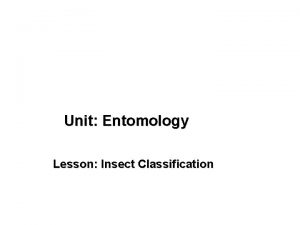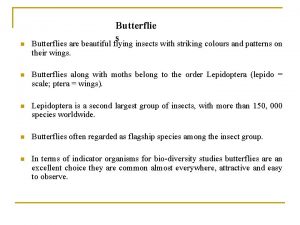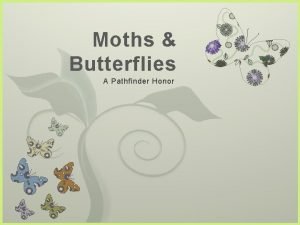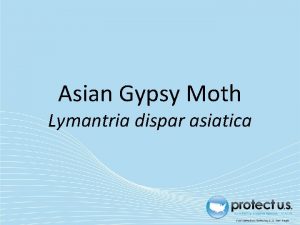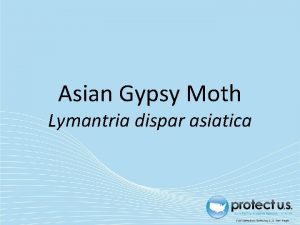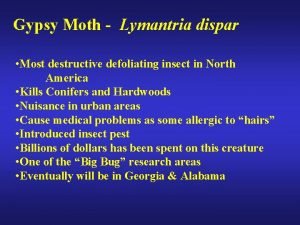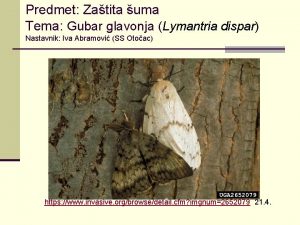Gypsy moths Lymantria dispar spp Order Lepidoptera family








- Slides: 8

Gypsy moths: Lymantria dispar spp. ▪ Order Lepidoptera, family Erebidae ▪ 2 subspecies of gypsy moths: Asian and European ▪ Native to Europe and Asia respectively ▪ Habitat: forests ▪ Larvae defoliate trees Male (dark) and female (light) moths. Photo courtesy of John Ghent, Bugwood. org

Gypsy moths: History and Distribution ▪ European ▪ Introduced late 1800’s New England – attempt to establish silk industry—now all over eastern U. S. ▪ Spread overland: when people move from infested states; firewood, timber, trains, cars ▪ Asian ▪ ▪ Multiple introductions, most eradicated International shipping is major pathway Lights draw them; eggs can survive trip Egg masses mostly likely to be found ▪ Isolated populations in WA being controlled A female moth. Photo courtesy of John Ghent, Bugwood. org

Gypsy moths: Biology ▪ Lays 100 -1000 eggs in a mass July- September, often near outdoor lighting, or in cracks/crevices, under boulders, under leaves or on bark ▪ Larvae hatch, disperse through ballooning on silk thread and wind; feed on plant leaves ▪ ~6 weeks later, pupate for 10 -14 days. ▪ Adults live 1 -3 weeks, don’t feed ▪ Populations may have outbreaks lasting a few years with greater damage Female moths laying egg masses. Photo courtesy of John Ghent, Bugwood. org

Gypsy moths: Biology ▪ Asian female moths fly, European females don’t ▪ Asian moths have broader host range than European, but similar preferences ▪ Over 600 species including: ▪ Alder, apple, poplar, oak, willow, elm, maple, birch, chestnut, hazel, beech, ash, walnut, spruce, pine, plum, pear, rose, and more ▪ Asian moth aggressively feeds on larch and willow; European on Oak species ▪ Capable of hybridizing Gypsy moth larvae. Photo courtesy of Jon Yuschock, Bugwood. org

Gypsy moths: Identification ▪ Egg masses: velvety, light tan to dark brown ▪ Larvae: 1. 6 mm when hatched, grow up to finger length ▪ Larvae fuzzy, with 5 pairs dark blue and 6 pairs red spots ▪ Adult males: grayish brown, 1. 5” wingspan ▪ Females larger, whitish, dark markings on wings, 2” wingspan Male (bottom) and female (top) moths. Photo courtesy of Tim Tigner, Virginia Department of Forestry, Bugwood. org

Gypsy moths: Impacts ▪ Larvae defoliate leaves—huge damage with large populations-weakens trees, more susceptible to other pests (pathogens and insects) which can kill host ▪ Reduces tree vigor and growth during outbreaks (1 -3 yrs) ▪ Suppresses preferred species, changes composition of forests ▪ > $35 million spent annually since 1980 to control European variety; $25 million total to eradicate Asian variety ▪ Timber loss: $72 million in Pennsylvania ▪ Lowers property values ▪ Losses in nursery industry Gypsy moth larvae eating leaves. Photo courtesy of Ferenc Lakatos, University of Sopron, Bugwood. org

Gypsy moths: Regulations ▪ Customs and Border protection keep it out—may require an infested vessel undergo treatment and/or be ordered out of port, into international waters, re-inspected, or refused entry ▪ Vessels from east Asia and Russia during egg-laying season expected to be certified before departing ▪ Certain counties quarantined— federal law requires inspections of outdoor items before moving from quarantine area Distribution map of European gypsy moth quarantine areas courtesy of USDA

Gypsy moths: Management ▪ WSDA: tens of thousands of traps yearly to survey; follow up with pesticide to eradicate ▪ Several pesticide and trap options for home use ▪ Vessels encouraged to self-inspect, removing and destroying all egg masses prior to arrival in US—incinerate, boil, or place in alcohol (don’t throw overboard! They might float to shore and hatch. ) ▪ Inspect outdoor equipment being moved crosscountry ▪ Inspect areas near lights and sheltered areas in particular. Milk carton traps. Photo courtesy of USDA Forest Service - Ogden, Bugwood. org
